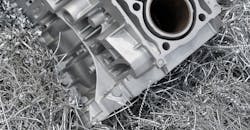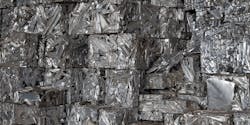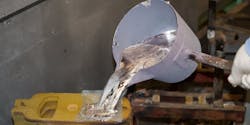With global trade in aluminum scrap increasing, it is essential to analyze the environmental impact of recycling. This study, focusing on Spain, integrates material flow analysis (MFA) with consequential life cycle assessment (CLCA) to project greenhouse gas (GHG) emissions from old scrap recycling. Findings suggest Spain's aluminum demand will be met mainly through primary aluminum imports, with excess scrap exported to Asia, resulting in GHG emission estimates ranging from -18,140 to -8,427 kg of CO2 eq. per ton of old scrap. Effective medium-term interventions include increased component dismantling before vehicle shredding, while long-term solutions may require automatic alloy sorting technologies. Cooperation between primary and secondary aluminum industries, the automotive sector, and end-of-life vehicle dismantlers is essential.
The increasing use of aluminum in the automotive industry, offering a lightweight alternative to steel, faces high costs and the need for advanced production technologies as barriers. This article highlights the benefits, limitations, and challenges of recycling aluminum parts from used cars, underscoring the importance of nonferrous metal recycling in a sustainability-driven world.
Growth sectors, growth factors
Aluminum is playing an increasingly vital role across various sectors of society owing to its versatile physical properties. Both alloyed and unalloyed aluminum are used in numerous products, in consumer and capital goods markets. The largest markets include transportation, packaging, construction, electrical, consumer durables, and machinery. The transportation sector, a significant global market for aluminum, encompasses the of automobiles, buses, trailers, ships, railroad and subway cars, aerospace applications, and mobile homes. Recent years have seen aluminum making significant inroads in automotive manufacturing too due to its lightweight and recyclable nature, aiding in meeting stringent fuel efficiency standards.
The success of the commercial aviation industry has also been heavily reliant on aluminum. Its combination of lightness, strength, workability, abundance, and low cost makes aluminum an ideal material for mass-produced commercial aircraft. For instance, a Boeing 747 jumbo jet contains approximately 75,000 kg of aluminum. As weight-reduction programs continue, forecasts predict rising aluminum usage, driven by the need to improve fuel efficiency and reduce emissions.1, 4
The growing cost of energy and concerns over waste management have driven recycling rates higher, but it is the economic benefits that have sustained growth in the recycled aluminum market. For aluminum manufacturers to meet the automotive industry's performance requirements, molten metal must be free of impurities, which has driven advances in recycling technologies and treatments for molten aluminum. Metalcasting, a technically challenging and energy-intensive process, is vital for producing a variety of products. Casting involves pouring molten metal into a mold, which is then removed after solidification. This process is competitive when producing parts with complex geometries or difficult-to-machine materials.2
The metalcasting industry faces pressures from stringent regulations aimed at minimizing waste and pollution, and from the need to remain cost-effective in a competitive global economy. Sustainability has become a crucial strategy to address these challenges. Sustainable development, as defined by the Brundtland Commission, is development that meets present needs without compromising future generations' ability to meet their needs. Manufacturing, including metalcasting, must evolve swiftly to align with these sustainability goals. A sustainable approach requires considering a product’s entire lifecycle, aiming to maximize environmental, economic, and social key performance indicators (KPIs.)3
Recycling aluminum for metalcasting
The recycling of light metals, particularly aluminum from End-of-Life Vehicles (ELVs), is crucial due to their high market value and significant demand in the automotive supply chain. Currently, automotive applications account for 40-50% of all aluminum scrap consumption, primarily in the form of castings. This study examines the trends and challenges associated with aluminum recycling in the automotive sector, with a focus on optimizing the reuse of scrap aluminum to meet future demands.4
Aluminum is a vital material in automotive manufacturing, offering benefits such as weight reduction and enhanced fuel efficiency. The high consumption of secondary aluminum in automotive applications is driven by the demand for castings that can accommodate higher alloying element specifications.
However, the rising use of wrought aluminum alloys presents a potential challenge: the automotive industry may produce more scrap than it can consume. This excess scrap could flood the market, driving down prices and creating a surplus that must be managed effectively.2, 5
Challenges in scrap utilization. The major challenges in using aluminum scrap include the varying compositions of wrought and cast alloys, impurity control, and the limitations of current recycling technologies. Impurity levels above 0.10% Fe are unacceptable for high-toughness aerospace alloys, and high-performance automotive alloys restrict both Si and Fe. The typical compositions of recycled metal show significant variations, complicating the recycling process. For instance, impurity accumulation in recycled streams poses a compositional barrier necessitating strategies to maintain high recycling rates and meet future demands efficiently.3
Trends and development. In North America, aluminum shipments for passenger cars and light trucks were expected to grow to 6.4 million pounds by 2009. This growth, coupled with stringent compositional limits for wrought alloys, could hinder the automotive market's ability to reuse its scrap under current practices.
An analysis of aluminum usage and scrap availability from 2003 to 2013 indicates that more scrap would be available than could be consumed, highlighting the need for improved recycling strategies.2
Advanced recycling technologies
Advanced recycling technologies such as automated sorting and shredding are essential to handle mixed-alloy scrap effectively. Automated sorting technologies like Laser Induced Breakdown Spectroscopy (LIBS) and X-ray Fluorescence (XRF) are being developed to improve the accuracy and efficiency of alloy sorting. These technologies enable identification and separation of different aluminum alloys, reducing contamination, and increasing the purity of recycled aluminum.3, 6
Broadening alloy specifications. Expanding the range of aluminum alloys that can accommodate higher impurity levels is another strategy to enhance recycling. By developing alloys with broader specifications, it becomes possible to use a wider variety of scrap materials, reducing the need for primary aluminum production and minimizing waste.2
Development of unialloys. Creating versatile alloys that meet the requirements of multiple applications, known as unialloys, can simplify the recycling process. These alloys can be designed to tolerate a range of impurity levels, making it easier to incorporate recycled aluminum into high-value applications without compromising performance.3
Enhancing collection and sorting. Building a robust infrastructure for efficient collection, sorting, and transportation of aluminum scrap is crucial for maximizing recycling rates. Improved collection systems can ensure that more aluminum scrap is captured and processed, reducing the amount of material that ends up in landfills.1
Promoting consumer participation. Encouraging consumers to participate in recycling programs through education and incentives is vital for increasing recycling rates. Public awareness campaigns can highlight the environmental and economic benefits of recycling aluminum, motivating consumers to recycle more and support sustainable practices.4
Future development
The future of aluminum recycling hinges on the development and application of advanced shredding and sorting technologies. Pursuing cost-effective re-melting processes, including the separation of undesired elements like iron, nickel, and vanadium through combination with zirconium, is crucial. Additionally, exploring alternative products such as Al-Fe deoxidizing agents can optimize the use of recycled aluminum that is not viable for new aluminum alloys.5
Developing new aluminum alloys directly from recycled materials should be a priority. Given the increasing importance of recycling due to dwindling natural reserves, efficient waste processing is essential. Recycling efforts must manage raw material flow to optimize reuse and recycling, preventing resource depletion. Waste management plays a vital role as a source of secondary raw materials.3
Urban and industrial growth, along with rising living standards, lead to increasing waste production. The key advantage of recycling is the ability to reuse metals like aluminum multiple times without degrading their properties. Nonferrous recycling, especially aluminum, offers practical solutions due to its stable properties throughout the recycling process. Aluminum containers and cans, ubiquitous in modern life, highlight the need for awareness and routine recycling practices.6
Legislative and economic drivers. Legislation, consumer awareness, and demand for recyclable products drive the need for environmental evaluations and sustainable practices. Lightweight aluminum, with its beneficial applications and high recycling value, is well-positioned for the future. The combination of maximum advantages and minimal resource input makes aluminum a strong and sustainable choice for various applications.5
Significant advances required
The future of aluminum recycling in metalcasting is promising but requires significant advances in technology and practices. Advanced shredding and sorting technologies, such as HVSC and LIBS processes, are essential to improve the efficiency and effectiveness of recycling operations. Pursuing cost-effective re-melting processes and exploring alternative products can optimize the use of recycled aluminum. Developing new aluminum alloys directly from recycled materials should be prioritized to meet future demands sustainably.6
Efficient waste processing and management are crucial to prevent resource depletion and optimize raw material flow. Urban and industrial growth, coupled with rising living standards, necessitate increased recycling efforts. Nonferrous recycling, especially aluminum, offers practical solutions due to aluminum’s stable properties throughout the recycling process. Promoting consumer awareness and participation in recycling programs is essential to increase recycling rates and support sustainable practices.5
The aluminum industry must collaborate with various stakeholders, including the automotive sector, end-of-life vehicle dismantlers, and policymakers, to develop and implement effective recycling strategies.
Engin Kılınç is a professional engineer with extensive experience in the automotive industry, specializing in aluminum casting operations and recycling technologies. Currently he serves as the foundry manager at Habaş Group in Kocaeli, Türkiye, overseeing installation, commissioning, and optimization of high-pressure and low-pressure casting machines for passenger vehicle production, including engine blocks, cylinder heads, and rims.
References
1. "Aluminum Recycling Market Size & Share Analysis - Growth Trends," Mordor Intelligence.
2. "Aluminum Scrap Recycling Market Size, Share & Trends [2023 Report]," Technavio.
3. “Aluminum Recycling Market Trends - Industry Analysis and Market Forecast," Mordor Intelligence.
4. "2023 Annual Report," The Aluminum Association.
5. "A look at the trends that will impact the primary and secondary aluminum markets in 2023 and beyond," Recycling Product News.
6. "Recycled Aluminum Market Report: Trends, Forecast and Competitive Analysis to 2030," Research and Markets.


